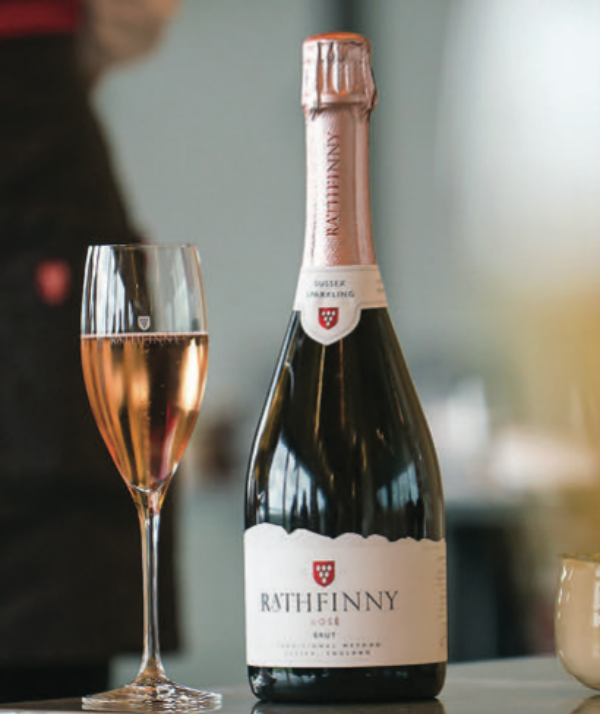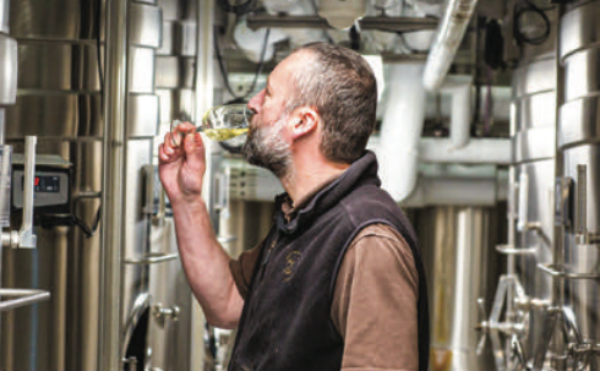All That Sparkles
Business is booming for makers of English sparkling wines. Ed Cumming heads to the South Downs to visit one of the nascent industry’s most exciting prospects, fizzing with ideas

By Ed Cumming
September 23 2019
On a sunny afternoon in September, Mark Driver is surveying his kingdom – the Rathfinny estate: 200 acres of gentle slope sheltered from the southwesterlies coming off the English Channel by a ridge of the South Downs. You could not conjure a more idyllic scene, or one better suited to growing wine. The sea breezes help lift disease from the plants. Running down the hill, the vines stand in straight rows, not quite ready for harvest. The 2019 crop, Driver says, will be some 20 per cent up on 2018, which was double that of 2017 thanks to last year’s glorious summer.
We taste the grapes. There’s earthy Chardonnay; Pinot Noir already brimming with fruit. The soil is free-draining silty clay, above a chalk seam that runs from Wiltshire down under the Channel and through northern France to Champagne, whose wines Driver has in his crosshairs. “It’s just the perfect spot for growing grapes,” he says. “It’s south facing, sheltered from the wind, and is a little bit dryer, warmer, and sunnier than other parts of the UK. If we become the English Krug, we’ll be doing okay,” he says, looking at the elegant visitor centre, where a crowd is assembling for tastings and lunches with a vineyard view.
Driver’s calm and genial manner belies an ambition that is characteristic of a new confidence in English sparkling wine. For years it was written off as a cottage industry, with only a few names, like Nyetimber, Hambledon and Chapel Down, breaking out of the realms of the specialists into broader awareness. But recently there has been a surge in new growers with big plans. Rathfinny is one of them. Driver bought the land in 2010, having retired young from a career in fund management, and since then has sunk a decade and more than £10 million of his own money into creating sparkling wines to rival the best. Rathfinny is now on the list at many of the capital’s best bars: at Richard Caring’s restaurants, the Savoy, the Ritz and the Connaught. In contrast to the classic biscuity Champagnes, English sparkling wines tend to be drier and Pinot Noir-dominated.

Thanks to climate change, the south of England finds itself in the sweet spot for growing sparkling wine. “We’ve had about a one degree increase in the average temperature over the past thirty years,” Driver says. “So we’re now more or less where Champagne was in the Fifties and Sixties.”
The French regions, in turn, must cope with being hotter than before. “They’re struggling now because they have to start picking at the end of August or early September. Ours have another four weeks to go.” “We’re stealing market share from Champagne, especially the entry-level wines,” he says. “A lot of lower priced wine comes across the Channel and is labelled as Champagne when it’s really not the same quality, whereas a lot of English sparkling wine is really up there. People want something local, want to know where it comes from, and that has lower food miles. Where we’ve struggled is where people already have a favourite, and love their Pol or Bolly. That’s a difficult market to tap in to. But more and more people are tasting our wines, and the quality is there.” This isn’t mere salesmanship. There are now more than 500 commercial vineyards in England and Wales, and last year’s harvest produced 15.6 million bottles, up from 4.2 million in 2016. Three million vines were planted this year, making it a fast-growing sector in agriculture. “When we bought the farm it was employing about one and a half people full-time,” Driver says. “We’re creating jobs in the countryside that simply weren’t there before.”

The French houses tremblent comme une feuille, chastened by results in blind tastings and declining sales. They want a piece of the action. In 2015 Tattinger bought a farm in Kent, planning its first drinking in 2023 as ‘Domaine Evremond’, named for a 17th-century Frenchman who introduced Champagne to London. Driver says they looked at buying Rathfinny, too, but he didn’t want to sell. “A lot of people said we were mad to turn them down, but what were they going to do?
Back then we hadn’t even released a wine, and now our wine is sold in the best places in London. I think it’s a much better story.” Pommery has released an English wine, grown in Hampshire. Bollinger and Louis Roederer are looking around, too. Investors have ploughed into Chapel Down, while Eric Hereema, a Dutchman with big plans, owns Nyetimber. “These are large, long-term business decisions,” Driver says. “In Kent, one vineyard just planted a million vines. That’s three times the size of our whole farm.”

The constraints on English wine are mainly financial. Land and salaries are more expensive than on the Continent, and England doesn’t yet have the scale of older regions. Brexit could bring lower tariffs on our sparkling wines, but has been a headache because so much equipment is imported and has had to be stockpiled ahead of possible port queues. But Driver doesn’t anticipate problems in terms of exports. “They make a lot of wine on the Continent, and some of it is pretty good,” he grins. “Our aim was that in 10 or 20 years you could walk into a bar in San Francisco or Beijing, and be asked, ‘Would you like a glass of Champagne, or a glass of Sussex?’ And it’s happening.”
